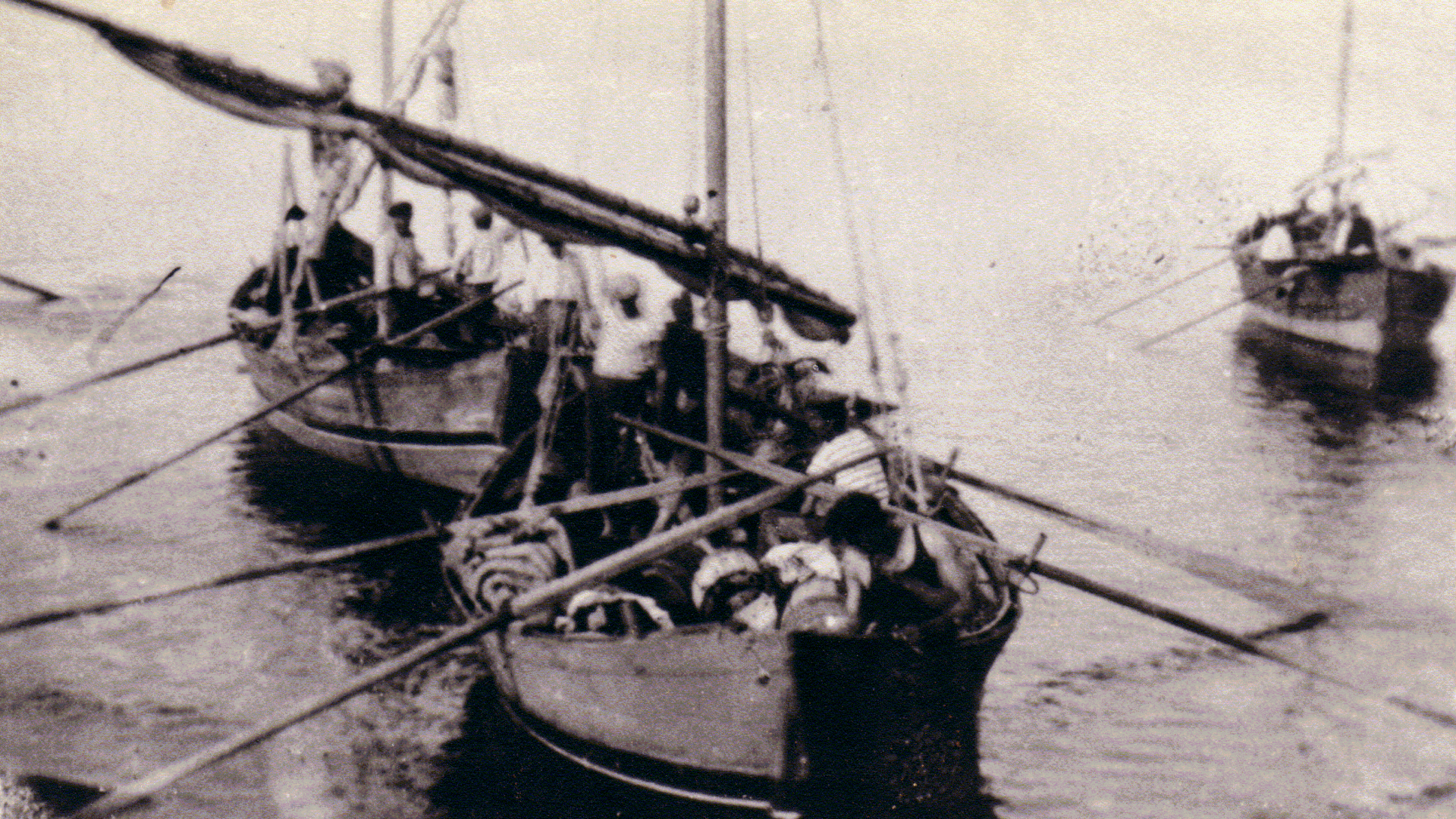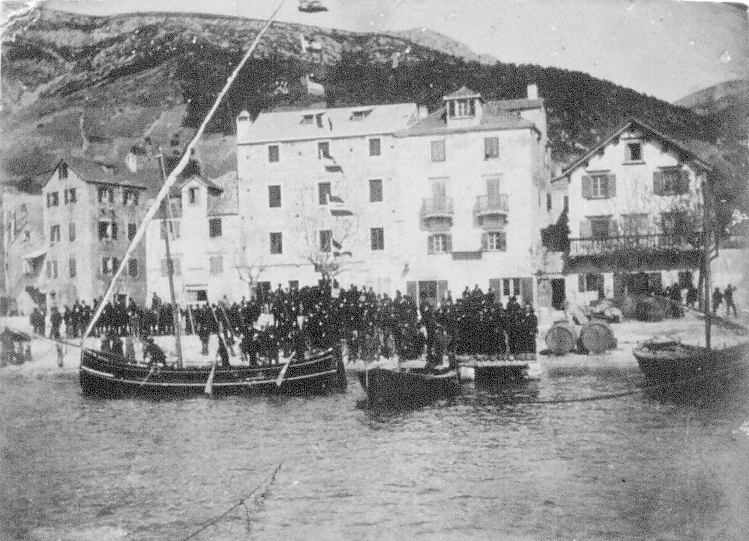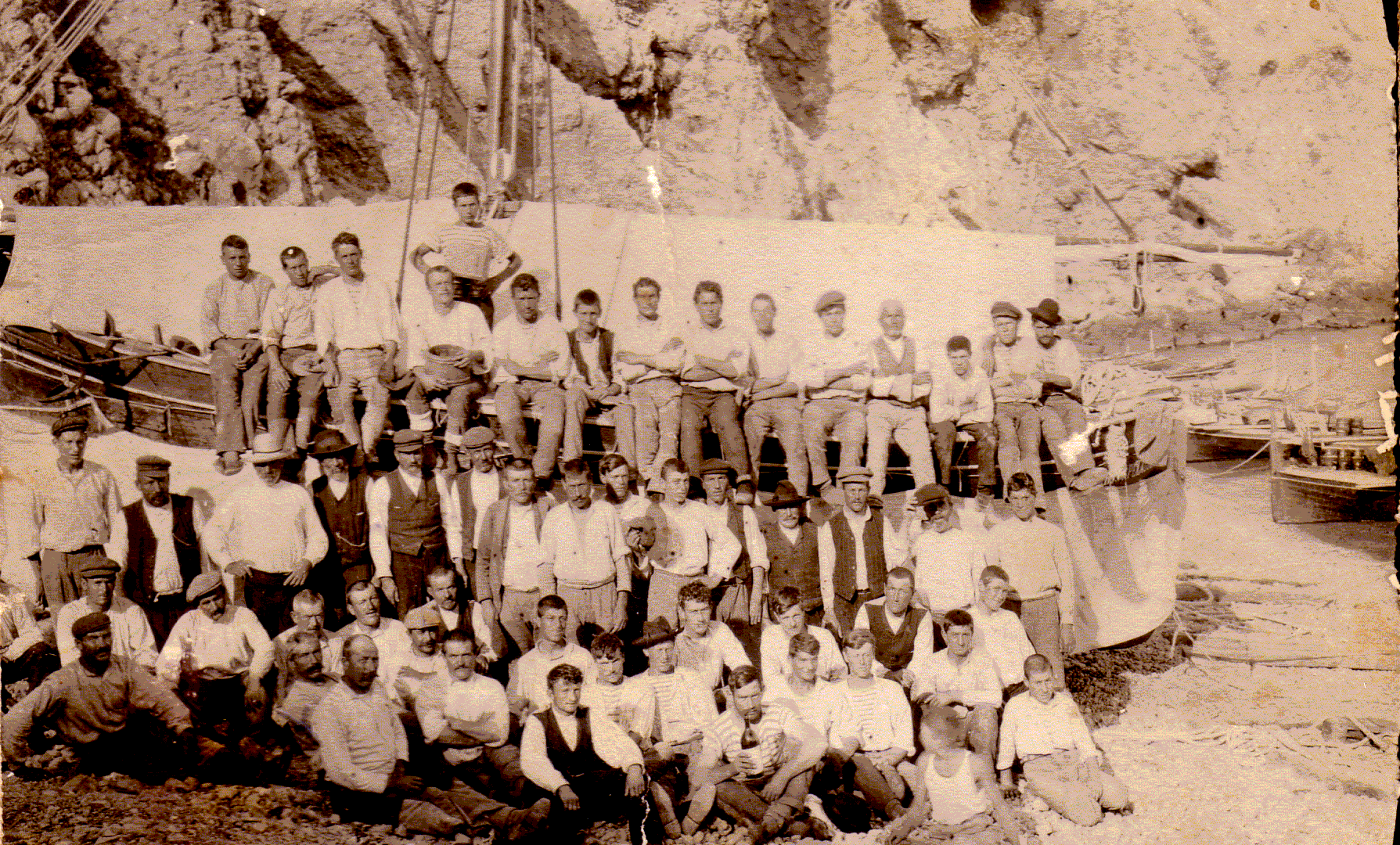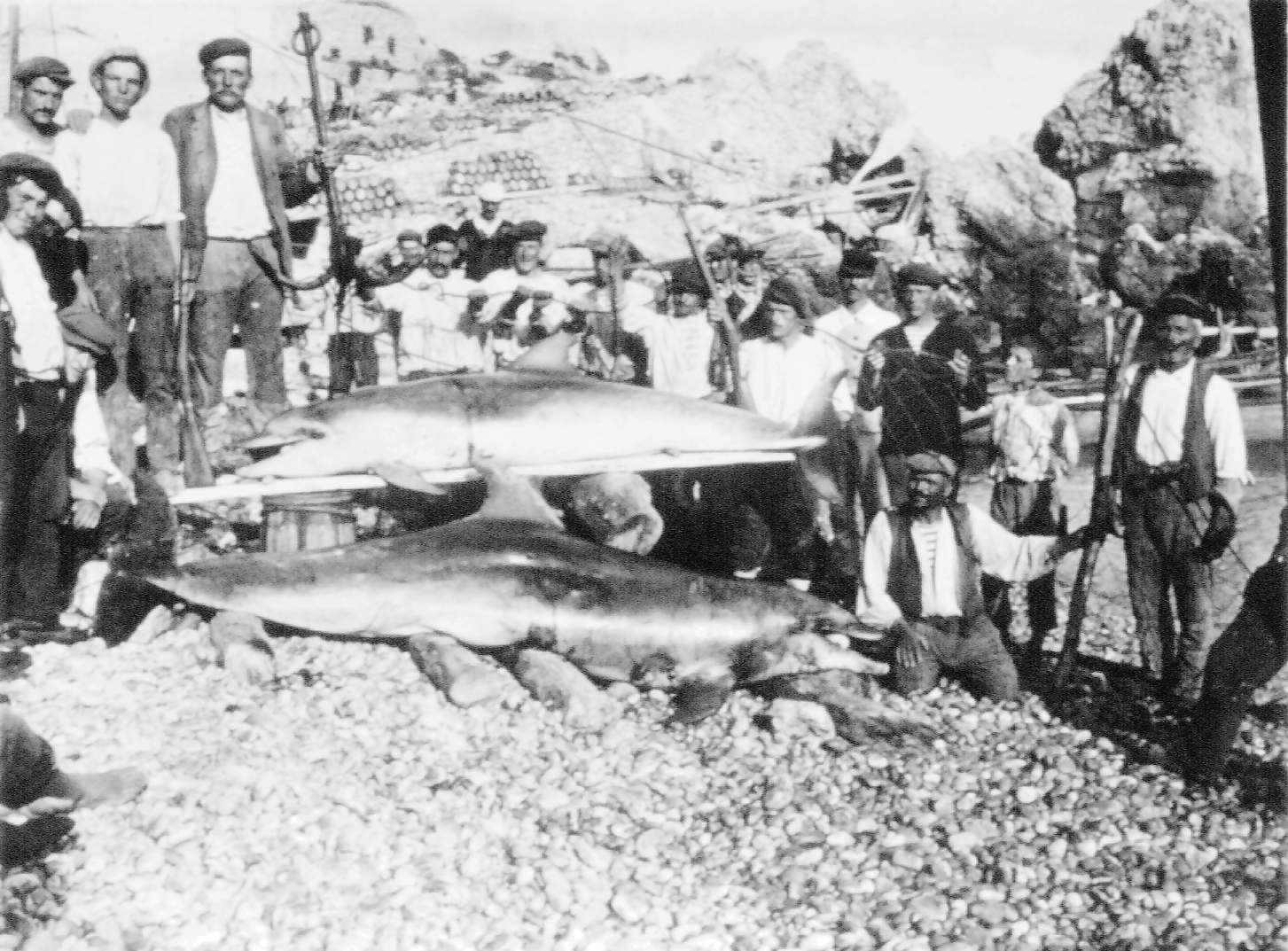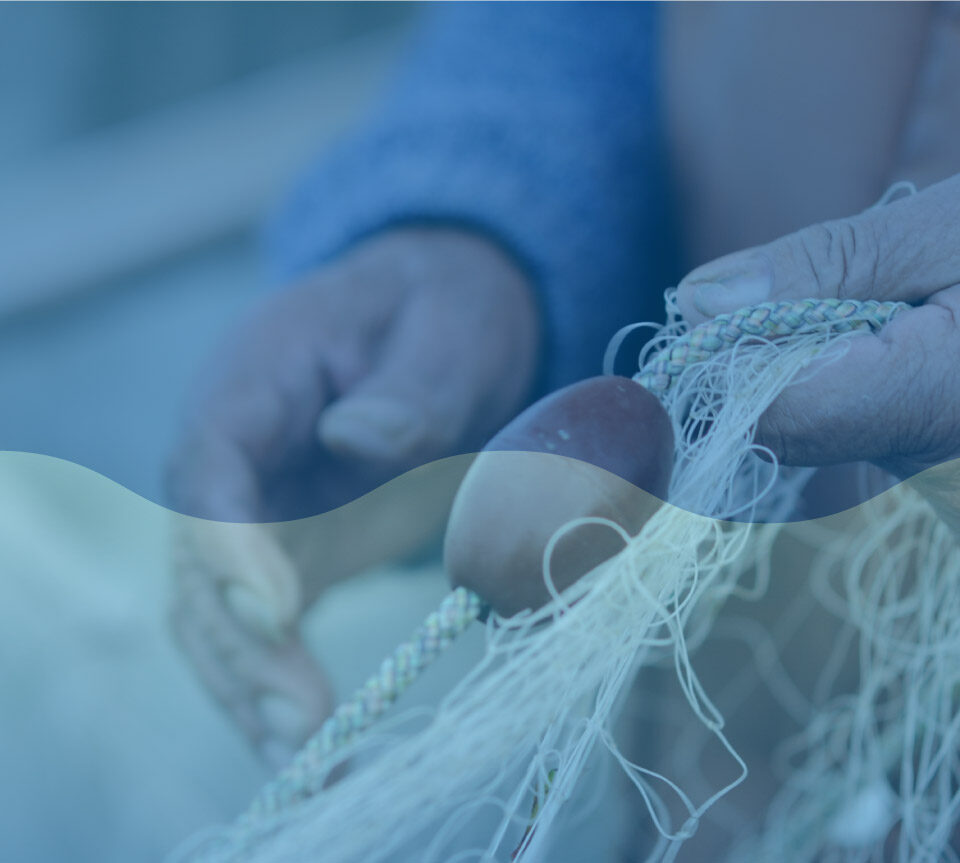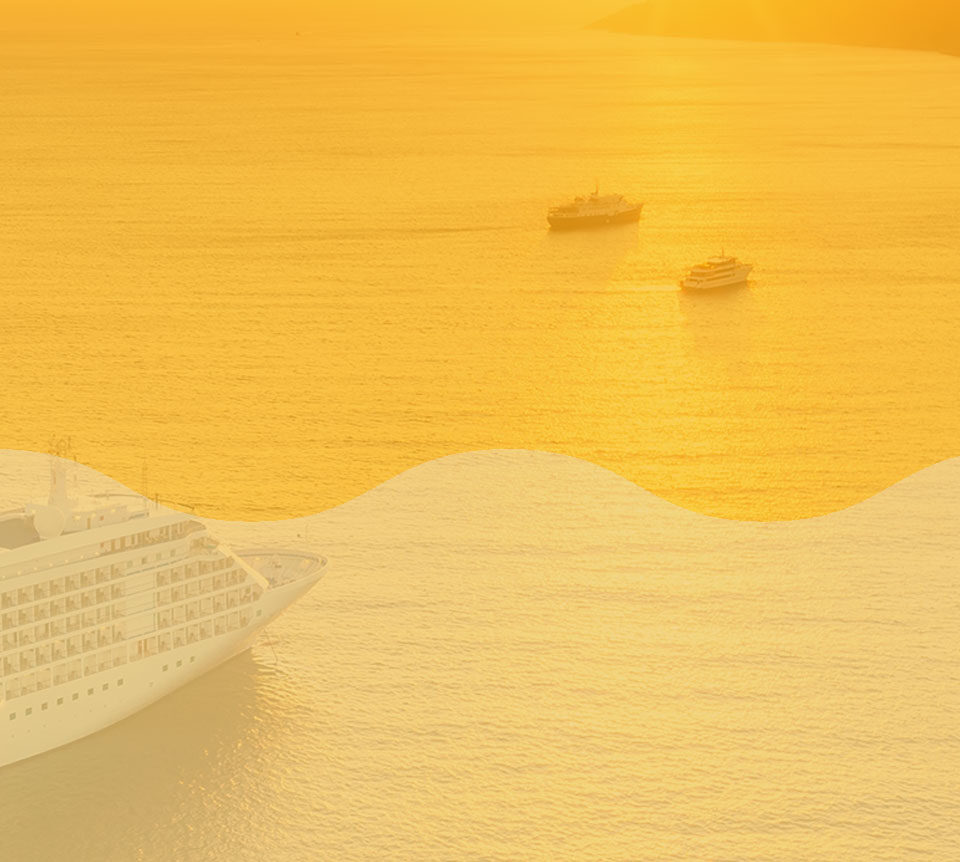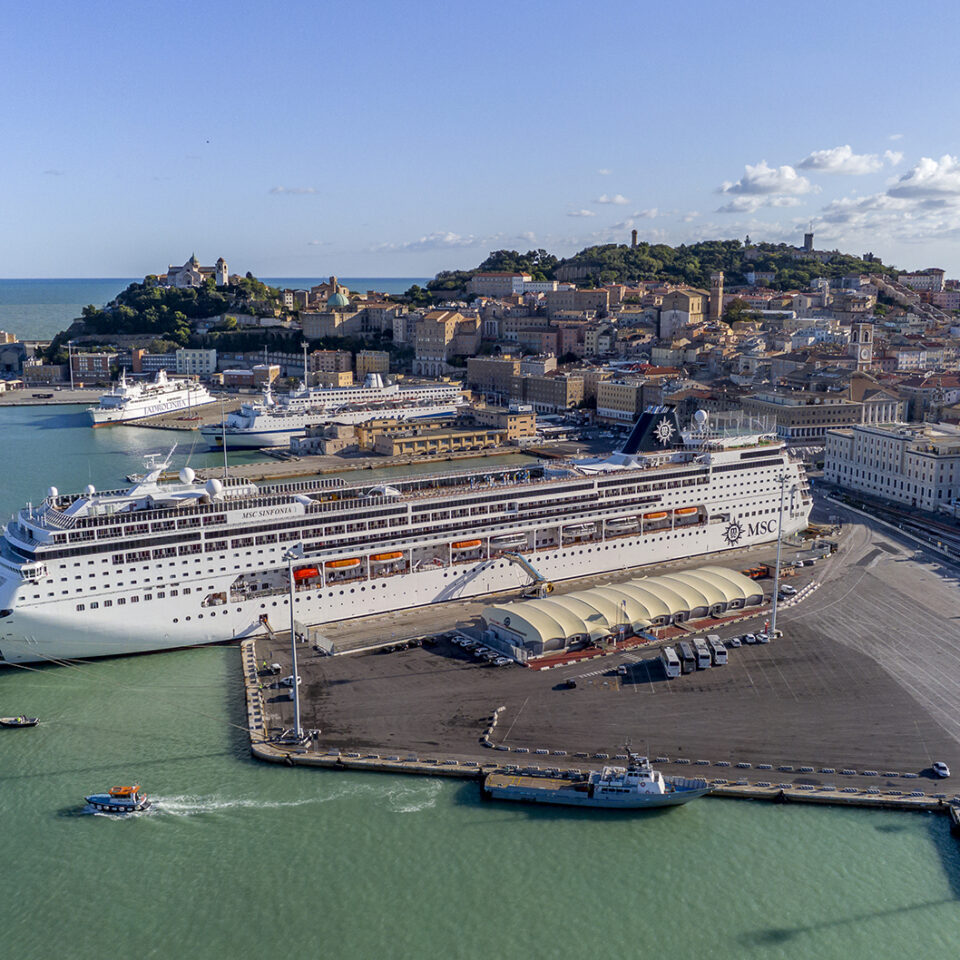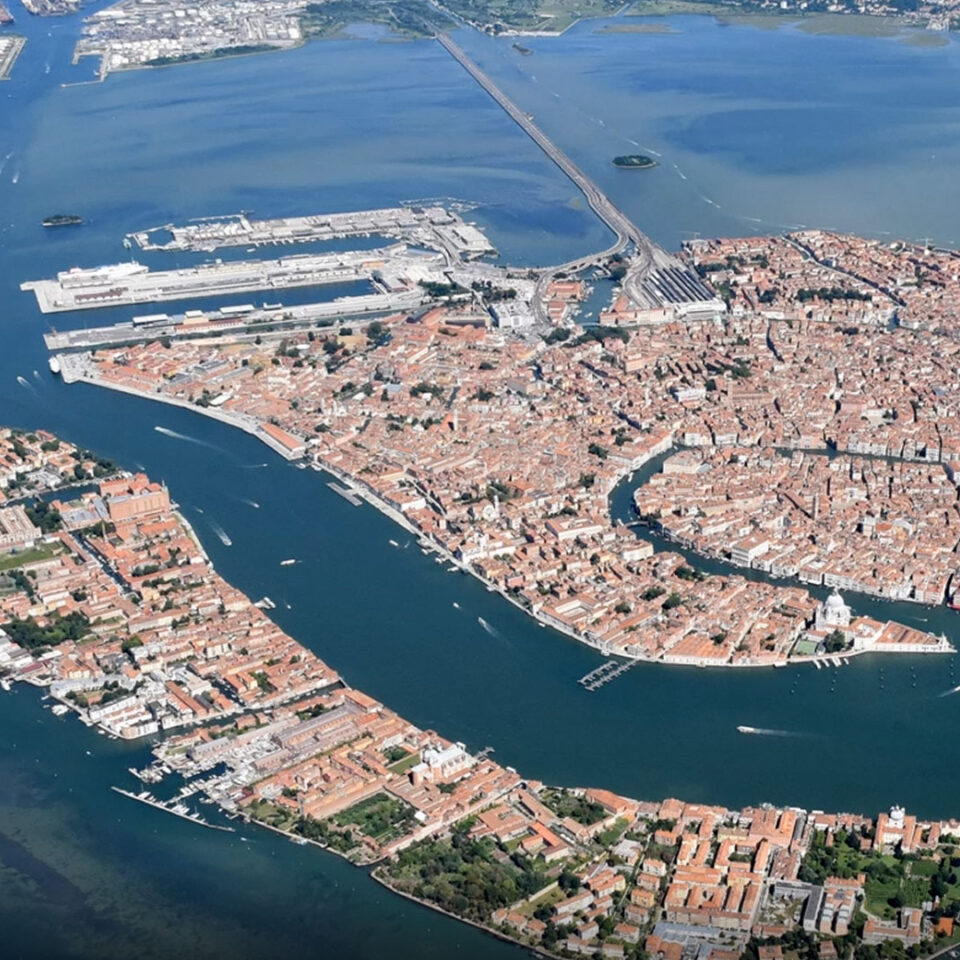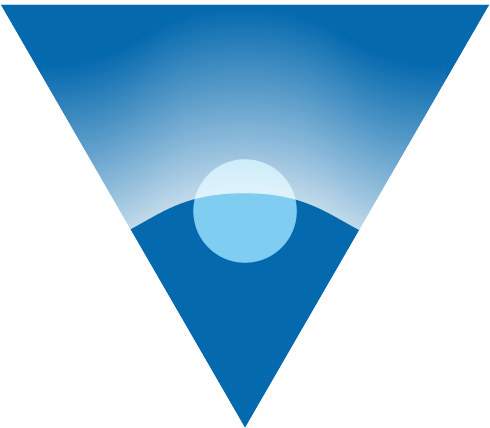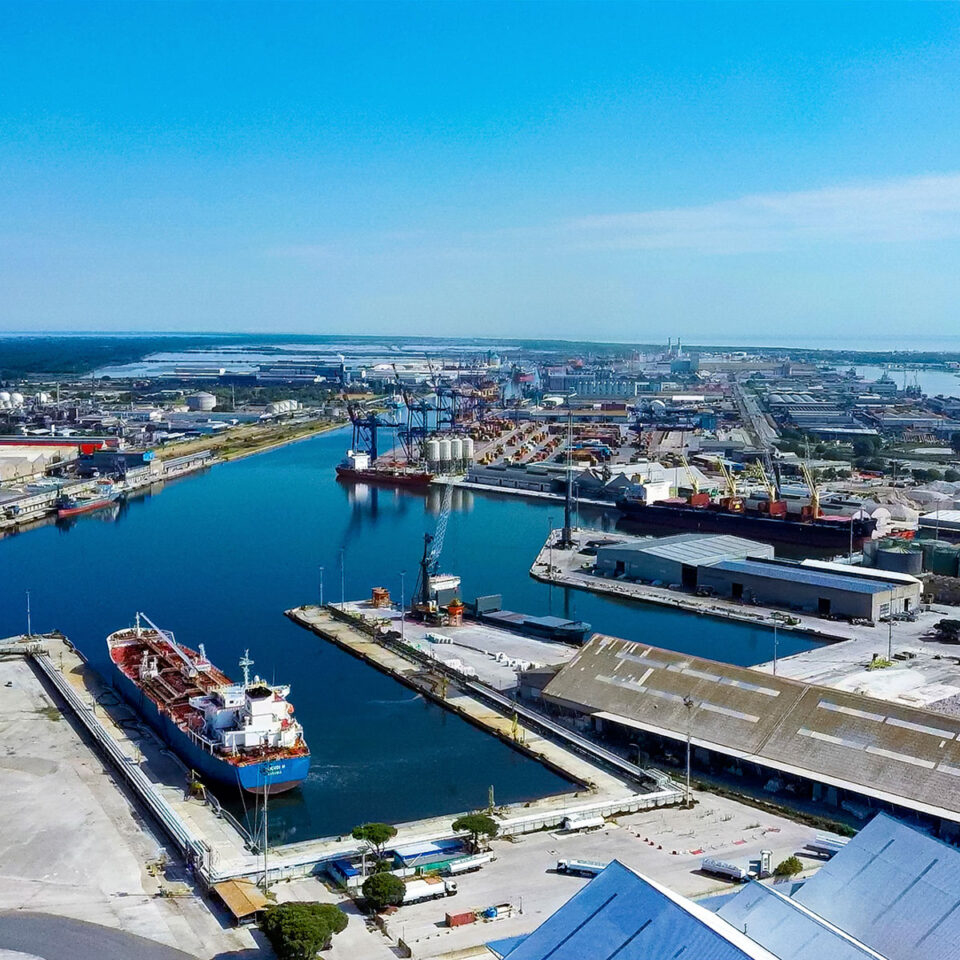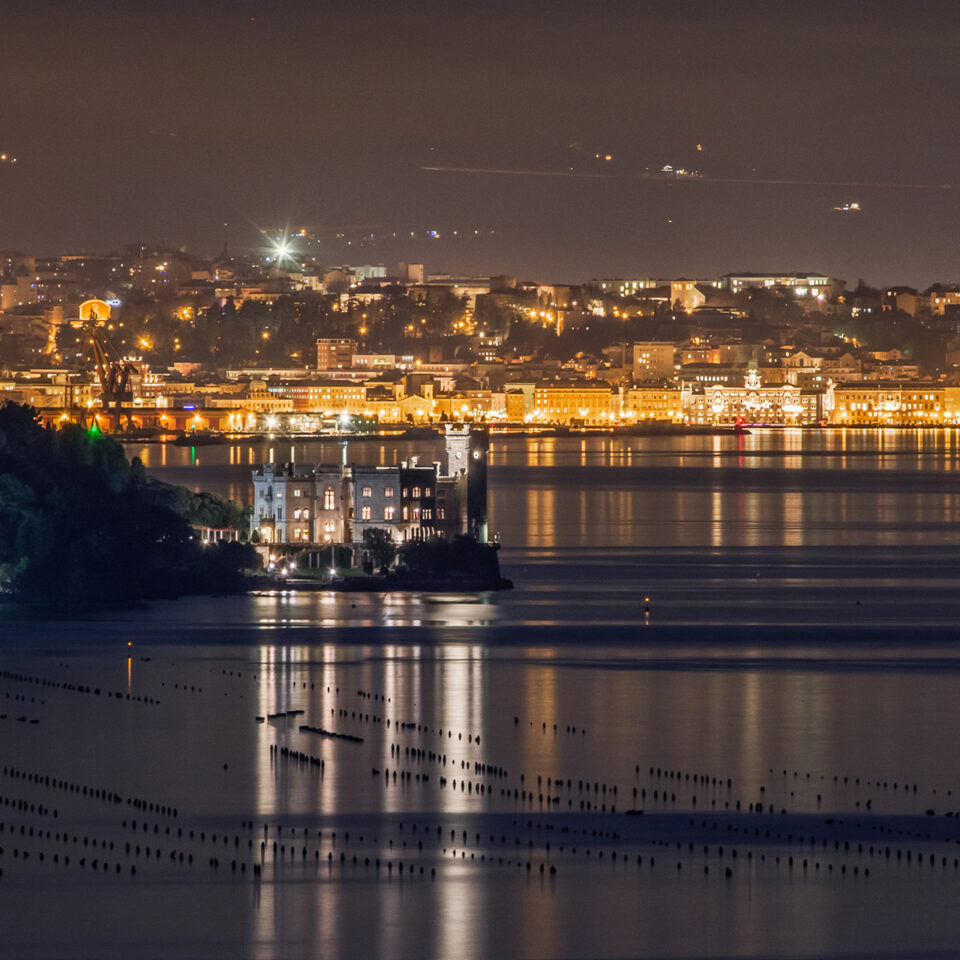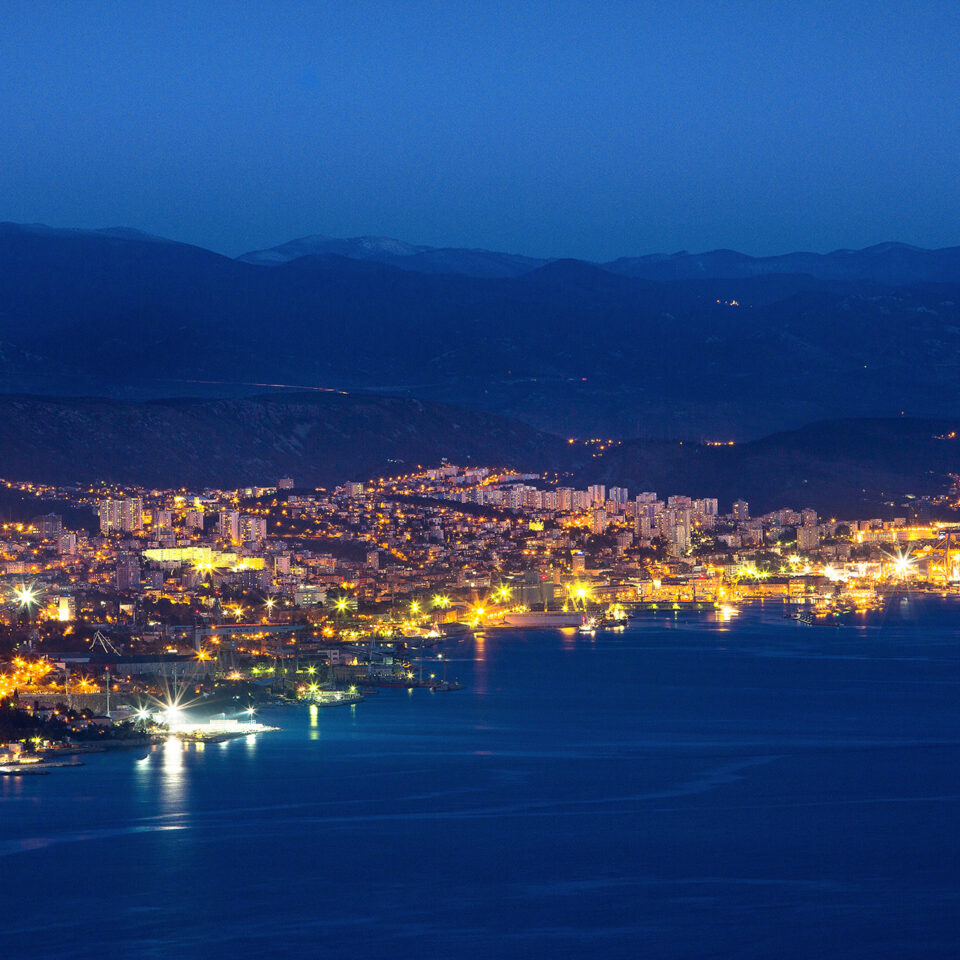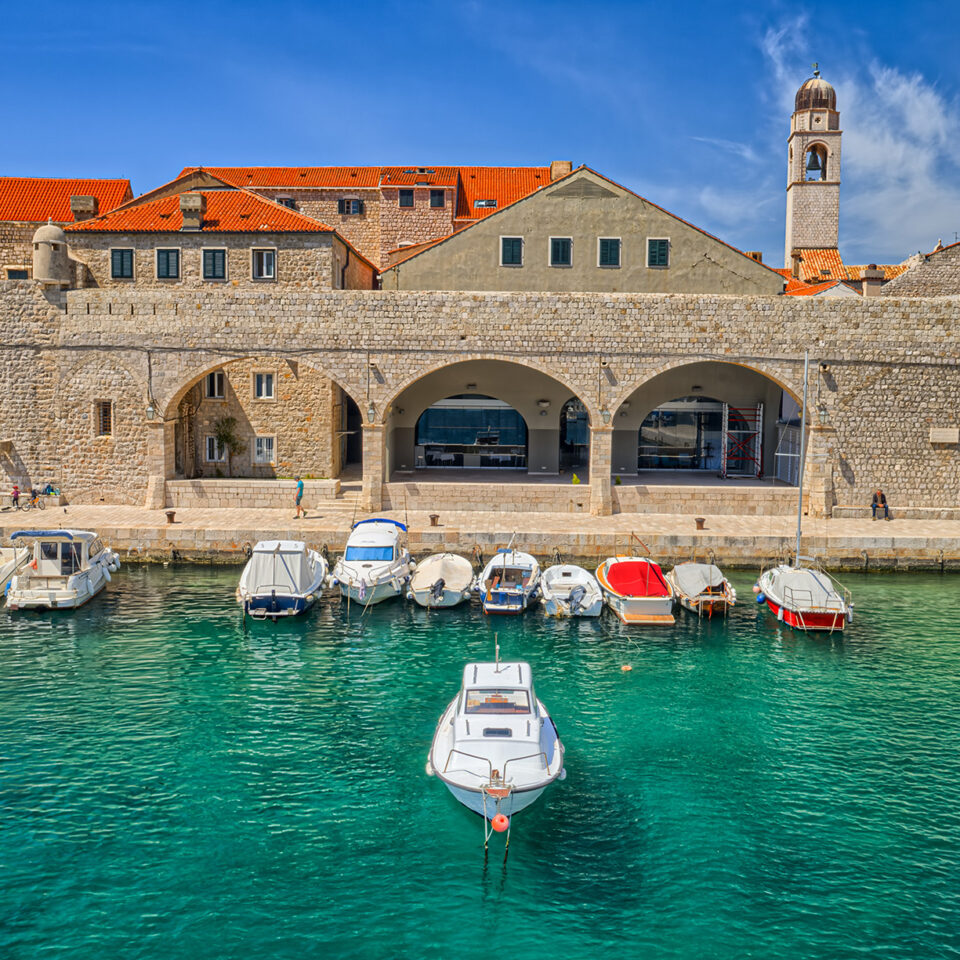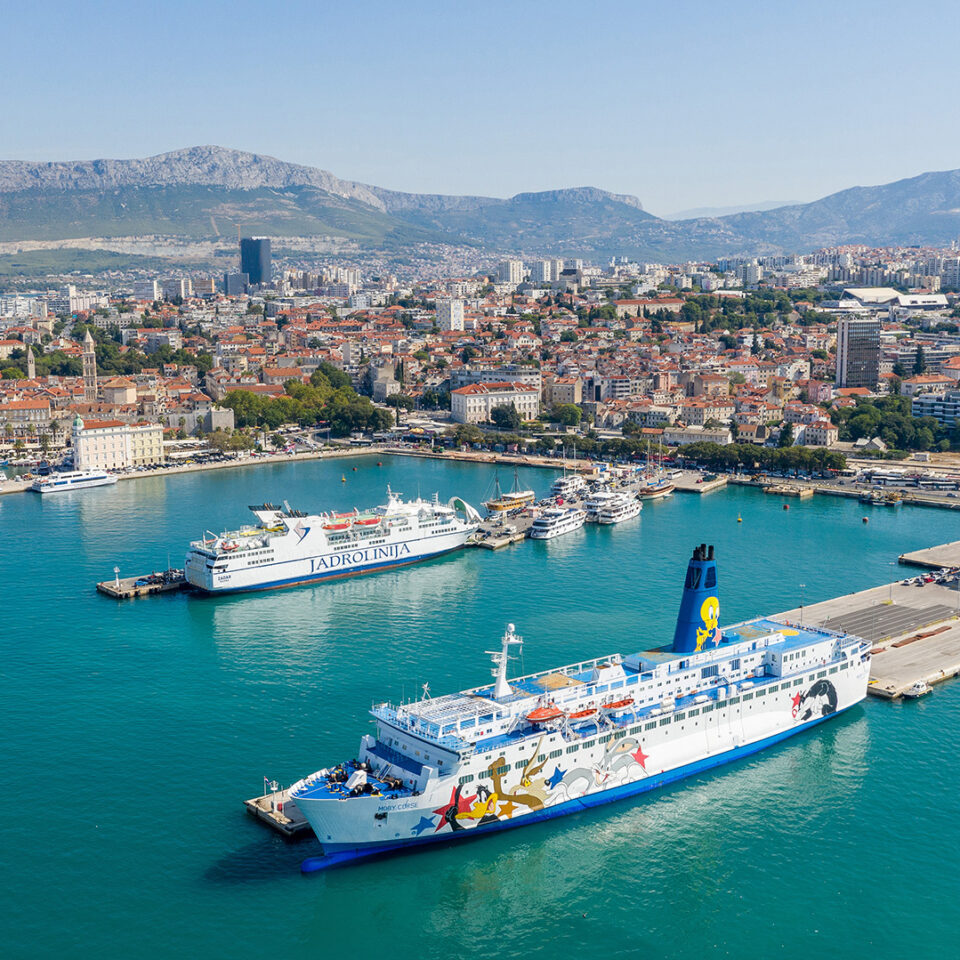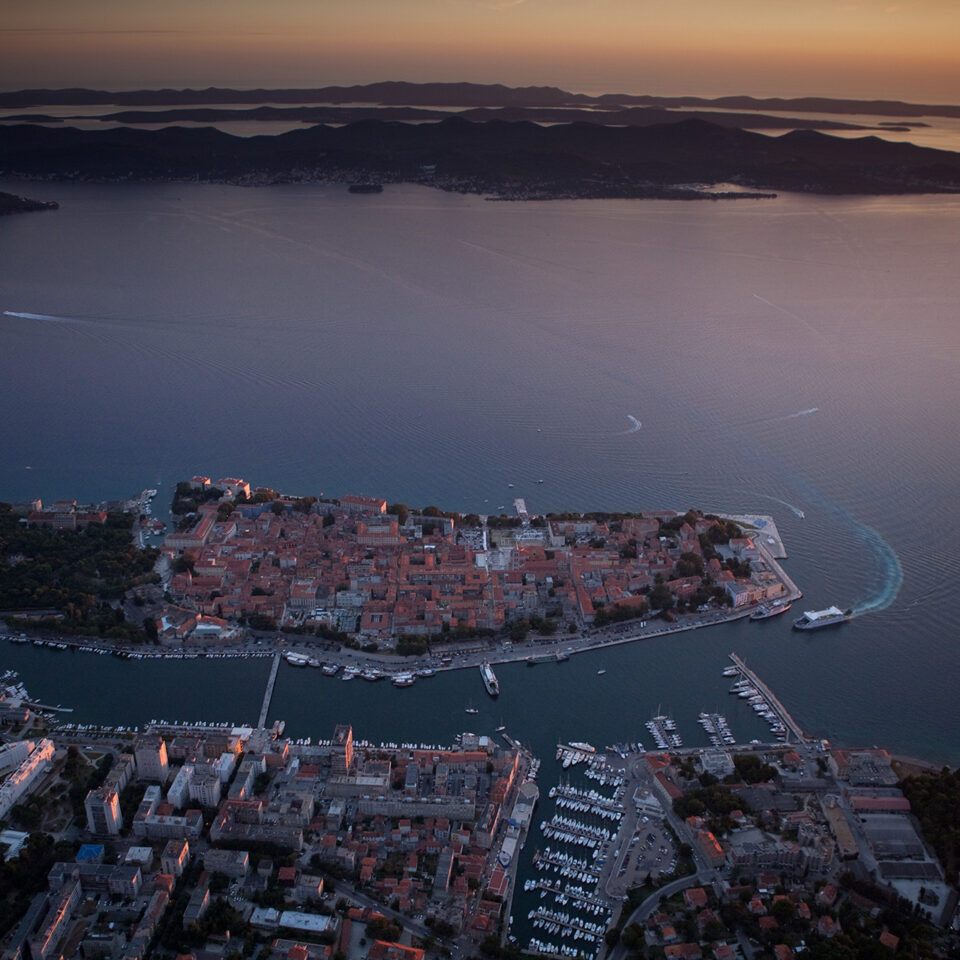

History of traditional fishing around adriatic islands with Vojga fishing nets
The pilchard-catchers with their small nets made the long voyage to Palagruža not just because of its rich fishing-ground, but because there was no room for them at the fishing posts around Vis and Biševo, which were reserved for the tratas, bigger nets coming also from as far away as Hvar and Brač. There were four times as many of these larger fishing družinas, each comprising fifteen to twenty fishermen on three or four boats, as there were convenient fishing positions around Vis and Biševo.
The trata equipment was expensive and the owners, especially those from Hvar, were rich and influential with the authorities. Most of them did not personally take part in the fishing, but they resented the presence of the vojga owners. By putting pressure on the authorities they managed to have the vojgari’s fishing rights restricted and even secured complete prohibition of the use of vojgas, and drastic measures were employed against any transgressors. The motive for such prohibitions was the suppression of competition, since pilchard caught by the vojga fetched a considerably higher price because of its quality. In addition, the owners of the tratas needed a large workforce and tried to fill their crews with vojga fishermen, who were especially respected as string oarsen and experts on the sea and on fishing. In years when the cath was poor, the authorities allowed the vojgas to be used near the big nets, but when the catch was abundant they were forbidden to fish even around Palagruža, where the underwater rocks and rocky shore were totally unsuited to the use of tratas.
Despite the Draconian laws prescribed by Venice and implemented by the state judges of the Hvar commune, the courageous fishermen opposed these unreasonable prohibitions and continued to fish throughout these centuries, risking losing their property and even their lives in order to survive.
There is a toponym Pol furkode on Mala Palagruža. Furkoda, also called morka, is a forked wooden rod used to support the mast and lug – lantina – in a horizontal position when ashore, as a frame for drying the sardelaras or pilchard nets. The name furkoda refers to an event which most probably took place in the 16th century. On the northern shore of Mala Palagruža the Komiža fishermen had an encounter with Italian fishermen from Apulia. The more numerous Komižans charged at them with their furkodas, damaging their boats and chasing them away from the island. This is recorded in Liber Comisae in a petition from the Komižans to the Venetian authorities requesting that the ban on vojga fishing around Palagruža be lifted.
The petition was written in the name of all Komižans and was signed on May 16th 1637 by Komiža procurators Antun Delić and Vinko Karuza and the headmen for the Palagruža fishing, Antun Maffio and Vid Bogdan. They emphasized that owners of vojgas and tratas had once enjoyed the same rights and cast lots together for the choice of fishing positions. When the vojgas lost those rights, they were also forbidden to fish around Palagruža, where they could not possibly interfere with the tratas. They also pointed out that the gaetas travelled to Palagruža in large numbers – over a hundred always taking part – for defence against pirates. The fishermen were praised for keeping watch and informing the navy and Venetian authorities about enemy ships, as Palagruža is nearer to Apulia then to Vis. They were also commended for chasing the Apulian fishermen off Palagruža.
On May 25th 1655 sentence was passed in absentia on twenty fishermen from Komiža accused of pilchard fishing around Palagruža. Part of the sentence reads: “Aware of their gross transgression they dare not return to face justice. To punish such outrageous insubordination we pronounce that absent subjects Bartul Zamberlin, Petar Petričević, Andrija Harvat, Petar Covo, Mihovil Pavšić, Pavao Bracan Jr., Franjo Fruzin, Jakov Galliot and Ivan Perina are exiled from this town and region, and from the Province of Dalmatia, for a period of ten consecutive years, and that they should approach no nearer than the tower of Klis. If during that time they are found in defiance of this exile and brought to justice, let them serve for five consecutive years as oarsmen, chained by their feet, on a Galley of the Most Serene Republic. Should any of them be incapable of such service, he shall be kept in jail for three years and then returned to exile (…). Anyone who catches or kills these offenders shall be rewarded one hundred liras for each, which shall be taken from the offender’s property if he has any, and otherwise one half of that amount from the funds of this Municipality (…).”
The Venetian authorities treated the vojga fishermen like bandits. Drastic measures were constantly invoked: fishermen were exiled from their homeland, sentenced to years of rowing on galleys bound in chains; their property was confiscated and their nets were burnt. The notice of General Overseer Alvis Mocenigo in 1697 regarding the ban on vojga pilchards fishing pronounced unpardonable punishment of “burning their boats and nets, fines of fifty ducats per net, exile, prison, hard labour (…)”.
In 1698 Komiža vojgari petitioned the Doge of Venice for permission to fish for pilchard on the grounds that “the Komiža region is part of the Island of Vis but is the most barren and infertile in the whole of Dalmatia, being on rocky ground and surrounded by bare hills. Nothing can be grown there because it lies in the jaws of the sea and its fertility is no better than that of Arabia. Komiža could be called Arabia were it not for the sea, which feeds about 18oo hapless souls (…) who survive through pilchard fishing using small nets called sardelaras, because their poverty precludes use of expensive tratas.” The fishermen talk of their value to Venice in its wars with the Turks, and complain of the hard penalties associated with the unjust prohibition of pilchard fishing using vojgas. They say that in order to survive they need to fish around the far-off islands of Sušac and Palagruža, where they are in great danger from pirates who have “in several incidents taken captive 176 men”.
The letter for the Doge was sent to the Council of the Wise in Venice in July 1696. By way of transfer, they were visited by Venetian warships and in 1700 their nets were burnt.
*****
On a dark night in July 1718, the whole southern coast of Vis is alight with fires of resinous pine burning on the svićala – the iron grids on the prows of the svjećaricas or lojas. Outside each bay the fires light the smooth surface of the sea, while pilchard and mackerel swim beneath them and leap around the boats pulled slowly ashore by strong oarsmen (šljovci), who carefully lure the shoals to a suitable place near the shore where the leut will encircle them with big tratas.
The leuts are anchored in the coves. Fishermen sleep below deck, waiting for the sound of the horn from the prow of the svjećarica, or for word from the barker in the borka, telling them to gather their nets and to pull them beneath the svjećarica to harvest the fish.
In the darkness between the fires stand the gaetas, and the vojgari now use their vojgas to catch pilchard which escape the tratas. The state has dispatched warrants for the arrest of the družinas, as criminals who are damaging its interests, accusing them of dispersing the shoals of fish with their nets, diverting masses of pilchard, causing periodic infertility of the sea. The state accuses and persecutes them, but the imperative of survival is stronger than the force of law. Despite the risk of arrest and severe punishment, they fish regularly as on this July night of 1718.
In the gap between two trata positions, between the coves of Smricevica and Taleška, a gaeta waits for the tratas to encircle their fish, to throw her vojga after the pilchard which escape. In this boat one crew member is Don Vicenco Julić, priest of Komiža. Suddenly a swishing of oars disturbs the silent summer’s night and a war galleon appears.
What happened then is described in the report of knez Pieter Loredan of Hvar to the Council of Ten in Venice. At his command, two armed ships were sent to Vis to catch several “criminal” vojgari and return them to Hvar for exemplary punishment. They encountered the boat carrying Don Vicenco Julić who “with his brother Nikola and three other vile followers, having changed his habit for the clothes of a scandalous vojga criminal (di scandaloso deliquente di Reti sardellare) has terribly offended God, his profession and the laws of this state”. The crew resisted arrest, and Don Vicenco and his brother lost their lives in their rebellion against Venetian injustice.
Ricardo d’Erco in his manuscript “History of Legislation on Sea Fishing in the Waters of the Austrian Littoral” (mid 19th century) wrote about the vojgari: ”The Winged Lion raged against them with all the force of its wounded authority at all times, excepting a few moments of truce. It persecuted them incessantly with confiscation, burning and threats of jail sentences, exile, hard labour and even death. Children lost their fathers, wives their husbands, and families were deprived of their sole breadwinner. But such cruelty led nowhere. As a hydra grows another, when its head has been cut off, the confiscated and burnt vojgas were replaced. The vojgari withstood Venice’s rage and remained untamed and undefeated in a ferocious struggle with the Venetian Republic over a period of two hundred years.”
In 1756 the Venice senate abolished its ruling of 1708 which gave Komižans the right to use sardelaras around Svetac, Sušac and Palagruža and the Komižans responded with a memorandum demanding reinstatement of the right. They were refused and subsequently a mission of thirty-six boats travelled to Venice to protest to the authorities, whose orders endangered their very survival. Their arguments were rejected and hey were returned to Komiža by an escort of war galleons.
In 1764 both boats and nets were ordered to be burnt, but the threat was not executed after the fishermen promised to refrain from using the vojgas. This was the time when the Venetian Republic, in its decline, wished to destroy this oldest form of fishing once and for all.
Francesco Grimani, then General Overseer for Dalmatia and Albania, proclaimed on August 14th 1756 the final eradication of the vojgas. The ultimatum to the Komižans was resolute: “Anyone who keeps vojgas must bring them to us and put them at our disposal within fifteen days from the day of this notice. Moved by pity, we shall dispose of them according to regulations which have the mildest effect on net owners, but in so doing we shall not deviate by a hair’s breadth from executing the aforesaid regulations. After the stated time has elapsed, we shall use a firm hand using war galleons to destroy and eradicate these nets wherever they may be.”
After this proclamation, nets were confiscated and burnt, and war galleons visited Komiža harbour several times to assist the authorities’ punitive action. “War galleons and punitive expeditions cruise in fishing waters”, says Mijo Mirković. “They confiscate nets and boats and capture men. The immediate motive is always the Komižans’ inflexibility, independence, love of freedom, ‘scandaloso libertinagio’ and ‘iniquo talento’.”
Despite these measures, the Komiža fishermen continued to use the forbidden nets because of their lack of fertile land and their long tradition of vojga fishing. “The miserable condition of the great mass of people”, says R. d’Erco, “was the reason why they neither wished nor were able to abandon the vojga either far from or near to their island; as a result, they remained fearless in their long struggle with the Venetian authorities.”
After the demise of the Venice Republic in 1797, Austria invaded Dalmatia and Komiža representatives went immediately to Zadar to seek a lifting of the ban on vojga fishing around Sušac, Svetac, Palagruža and Biševo from the new authorities.
On Februari 3rd 1798 there was a big celebration in Komiža. The Court Organising Commission in Zadar had granted their petition. Thus began a new era in Komiža’s fishing history, with a new and gentler attitude to the vojga than had been shown by the Winged Lion rulers.
But Austria’s rule was brief. Dalmatia came under Napoleon in 1806 and Vicenzo Dandolo, a chemist from Venice, became General Overseer in this Province. Dandolo worked particularly had on improvements in fishing. His name was associated with the famous Regulations on fishing (Regolamento sulla Pesca in Dalmazia), popularly called “Dandolo’s Decree”.
Based on common law, his Regulations of 1808 contributed to the development of fishing in Dalmatia, while still retaining an element of prejudice against the vojga.
The new Regulations gave Komiža the right to fish on Svetac and Palagruža, and Vis to fish on Sušac. “Dandolo’s Decree” forbade vojgas around the islands of Vis and Biševo, so the Komižans made fishing expeditions in big regattas to Palagruža where they enjoyed exclusive rights to use vojgas.
During English rule on Vis, from 1811 to 1815, the island became a centre of trade and black-marketeering on the Adriatic. Vis had twelve thousand inhabitants during this interval of prosperity – more than ever before. They were no longer bound by “Dandalo’s Decree” and fished freely around their island, an activity considered by the authorities to be irrelevant to their interests. Trade was now the source of wealth, and the English called the island “Gibraltar of the Adriatic” because of its importance for their strategy in dealing with Napoleon’s continental blockade.
In 1815 Austria resumed the governing of Vis until its empire crumbled in 1918. The trade brought by the English withered and the island lived as in previous centuries from its produce of wine and fish.
Liberal fishing regulations enabled an increase in the number of fishermen and fishing equipment, so that by 1847 there were about seventy tratas and over two hundred špurtenjaci or vojga fishing crews. The waters of the Vis Archipelago had been too small for these fishermen in previous centuries but now, under Austran rule, they had a chance to discontinue their joint fishing with Hvar and Brač. They succeeded in 1872.
At the same time, Komižans tried to free themselves from their obligation to Hvar Cathedral by which they donated 1/3 of their catch from their best fishing ground of Trešjavac on Biševo.
When lots were cast in 1848 they omitted Trešjavac on pretence of its being of no importance, and assigned it to the Hvar chapter to fish for themselves. Only in the second half of the 19th century did they finally succeed in obtaining the right to fish freely in their region without paying dues to the Hvar Commune, which practice had been to a great extent the foundation of the Hvar gentry’s prosperity. “The truth is well known to everyone”, says Vicenzo Dandolo, “All those castles on the islands, which during harder times turned to ruins, were built in past centuries from the proceeds of fishing.”
And not only the gentry’s castles but the Cathedral itself, the monumental building in the centre of Hvar, was built on the earnings from pilchard. In 1621 the Hvar Commune authorities ruled that 1/3 of the income from the catch on Trešjavac over a period of ten years was to be used towards its construction. This taxation subsequently became an on-going right of the Church and was abolished only after two hundred and fifty years, having been Hvar Commune’s principal source of income for centuries. The 1644 report of Giovanni Battista Grimani, General Overseer for Dalmatia and Albania, included a list of the Hvar Commune Treasury’s sources of income, showing that it’s emoluments from the Komiža and Biševo catches were almost four times that from the fishing around Hvar itself.
In his Itinerary (Venice 1774), Alberto Fortis says that according to geographer A. Friedrich Buching the whole of Italy and a good part of the Levant were supplied with pilchard from Hvar and its dependent, Vis.
Analysis of these documents shows that Komiža was the centre of the Adriatic fishing world. The crucial reason for this was not only the richness of its fishing grounds, but that despite constant prohibitions it had preserved the primitive yet most profitable method of catching pilchard using the vojga.
“The supremacy of these fishermen from Komiža and Vis”, says Mijo Mirković, “lay in the fact that they sought different passages of fish, distant reefs and islands, especially Palagruža, where the fishing ground was not convenient for tratas.”
Catching pelagic fish with tratas is restricted to certain types of ground. Most frequently, the tratas are used in bays with flat and sandy bottoms and where the shore is such that the net can be conveniently hauled. The ordinary trata is placed so that the fish can be drawn into its mesh and caught. With the invention of the purse-seine at the beginning of the 20th century, the trata was doomed because the new net did not require a particular geographical formation, but instead could be taken in search of the fish. All the same, it was nearly half a century – 1946 – before the purse-seine was introduced in Komiža as a more efficient fishing tool. Long tradition of using tratas in other places prevented introduction of purse-seines, but in Komiža this radical change was more readily accepted since the trata was not the preferred tool.
Still, the principle of active pursuit of fish existed here long before the purse-seine, from times immemorial, when pelagic fish was caught using vojgas. Unlike the trata, the vojga is independent of the configuration of sea-bed and shore. It is not used passively, in the sense of being placed for the fish to appear at a certain place, but is taken in search of the catch.
The State punished vojga users and favoured the trata as more effective and more useful. Although a trata could catch several tens of tonnes of fish in one haul, the vojga was still more efficient because of its active principle. In addition the associated equipment was cheap and fewer men were needed during the catch. These facts are confirmed by many documents in Liber Comesae. A statement given by Notary Public Vecenco Kuljiš on August 18th 1788 quoted customs tax collectors in Komiža as saying that vojgas yielded six times more income than tratas.
The Komiža parish priest, Don Matija Vranjican Papica, gave a sworn statement to the Notary Public on September 7th 1788 to the effect that his more able parishioners fished with vojgas and less able with tratas. He reported that vojgas could catch more fish in one year than could the others in ten.
Ricardo d’Erco produces “accounts with comparisons of capital needed for fishing with tratas and vojgas” made by one Vušković. Both capital invested and income produced were five times geater for the vojgas.
In addition, the trata owners devastated forests by using wood for producing light on their boats, and pine-bark for greasing their nets and ropes. The Komiža tratas used so much wood that they had to begin importing pine-wood from Apulia in order to make up for the forests ravaged at home.
The success of vojgas lies also in their ability to harvest fish in the rich but inaccessible grounds around Palagruža which would otherwise have been left to the seagulls, terns, dolphins and seals. Thus optimal exploitation of the vast Vis Archipelago, especially its distant islets, was only possible using the dynamic principle of the vojga. The vojga had another minor advantage in that it did not postulate the degradation of the fisherman to the status of hired hand.
The ordinary trata fisherman represented a physical workforce harnessed either to the oar or to a belt (krok) at the end of the rope used in pulling the trata towards the shore. He did not need to know all the secrets of fishing skills and crafts, since he merely obeyed orders from he parun or the svićar. These fishermen were mostly strangers who came to Komiža from the Dalmatian coast and interior islands, frequently from Drvenik, so that in Komiža the word Darvencanin is a synonym for a hired hand.
The trata owner was not often an active fisherman. Rather he was rich, and hired out his boats and nets. The parun did the fishing in their stead, whilst protecting their interests and commanding the fishing crew.
The vojga crew (called špurtenjaca) was much more compact. It consisted of five men, usually including the boat owner as svićar and master. Despite his grater skills and responsibility, he and the ordinary crew members, his comrades, took equal parts of the catch; but as owner he additionally took two parts for the nets and one part for the boat.
Such equality and mutual respect among the crew members, accompanied by inviolable authority of the leader, based only on his knowledge, justice and responsibility, enabled each member of the družina to preserve his dignity and individuality.
In contrast to the teams handling the trata, a vojga crew formed an autonomous production system. They were not merely a workforce but needed diverse skills, ranging from the techniques used in repairing and protecting the nets, to those needed for the building and maintenance of the boat. They also had to be skilled navigators and meteorologists, strong oarsmen and good sailors. They needed to know the stars, winds and currents and to memorise the contours of the sea-bed. They had to know the disposition of the fish (according to proverb, the pilchard is said to have as many moods as there are brambles), and the influence of cosmic powers on their behaviour. They had to be skilful fishermen, able to recognize the type of fish and the size and depth of the shoals in complete darkness from their phosphorescence. They also had to know how to preserve the fish for the buyers from the Levant and the western Adriatic coast. Exposed as they were to attacks from pirates on far-off reefs, they also had to be able to defend themselves. And, in addition to all that, they were persecuted by the authorities and had to devise means of outwitting them.
Komiža had the greatest number of vojgari, yet there was little antagonism between them and the tratari. The owners of the Hvar tratas who fished around Vis and Biševo, on the other hand, demanded prohibition of the vojga. Their arguments that vojga fishing was not profitable were based on the yields of the vojga catch around Hvar, which indeed was poor, so that very few vojgas fished there. “If the Hvar vojgas caught so little pilchard”, says R. d’Erco, “this must have been due to the barrenness of the fishing ground as well as to the limited number of vojgas. Let them fish without unpleasant restrictions in places where there is more fish and use more vojgas, then there will be no reason to say these nets are useless.” He substantiates this argument with particulars of vojga fishing around Sušac and Palagruža, where “there were cases in which a vojga consisting of 16 budels caught 100,000 pilchard in just one dip”.
Liber Comisae contains several documents which prove the coexistence of tratas and vojgas. On September 3rd 1788 twenty two signatures of trata owners in Komiža were listed, stating that they did not agree to the ban on vojga fishing.
Richard d’Erco, Councillor with the Central Coastal Authorities in Trieste, received a letter from Petar Marinković, the secretary of Komiža Municipality, which indicates the status of vojgas among Komižans: “In frequent talks with fishermen and other people I have become convinced that the general opinion is that the vojgas are of great utility and I was also persuaded that they did not blame the absence of pilchard in one place on the presence of vojgas.”
These examples of coexistence gave d’Erco the strongest argument in support of vojgas. During the first moonless period in 1852, not one pilchard was caught in the waters of Vis and Biševo. On the same occasion, Komižans were fishing near the small island of Pianosa, near Monte Gargano, where they caught two hundred barrels of pilchard. Another example occurred in 1860 when seven thousand three hundred barrels of pilchard and one thousand three hundred barrels of mackerel were caught. The tratas produced only 1/9 of the catch. Between 1858 and 1861, the tratas earned only twenty thousand florins when the whole income from fishing on Vis was seven hundred thousand.
At a meeting of Komiža vojgari and tratari called by d’Erco in 1852 to hear opinions of the regulations which he intended to suggest to the authorities, the men did not attempt to deny vojgari the right to fish together with the tratari. D’Erco quoted one “impartial trata owner”as saying that vojgas were useful – in fact more so than tratas and reported that this was not challenged by anybody at the meeting.
After almost three centuries of persecution of vojgari, the superstitions connected with their use finally began to fade. We saw earlier that even the fishing reformer Vicenzo Dandolo could not quite shake them off. Only on the appearance of Ricardo d’Erco, inspector for the Central Marine Authorities in Trieste and expert on fishing in the eastern Adriatic, did the natural rights of the vojgari start to be restored in Law, as a result of his extensive research of fishing and fishing legislation.
Around the mid 19th century there were about fifty tratas in Komiža and over a hundred and thirty vojga. In Vis, there were twenty five tratas and nearly ninety špurtenjaci (vojga crews). In the fishing season from April to October over two thousand fishermen participated and they constituted Dalmatia’s biggest food producer and exporter.
According to the 1873 figures compiled by L. Maschek and reported by Josip Basioli, the amount of salt used for pilchard preservation exceeded three hundred and forty tons per annum and twenty thousand barrels of salted fish were exported to Greece and Italy. Since one barrel contained around fifty-five kilograms of fresh fish, this implies that the Island of Vis was exporting more than a million kilograms of salted fish each year.
The large market in salted fish started to diminish during the second half of the 19th century. Two factors contributed to this: the expansion of fishing in the Mediterranean, and policy of the Greek customs of reducing the import of salted fish from the Adriatic.

